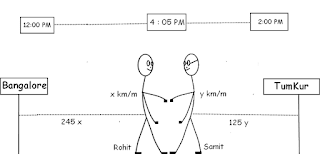Locations of 4 Friends
What was the given data & question?
Let's represent houses of friends by their initial letter of the name i.e. C is the house of Chris, D is the house of Darren, B is Bill's house & A is name of Alex's house.
Now C & A are located at 60 km away from each other while D & B are 40 km apart i.e. CA = 60 & DB = 40.
As per given data, D is 10 km nearer than B from C. Hence, CB = CD + 10
There are 5 possibilities of the locations of these 4 friends.
Case 1. D & B are in between C & A.
In this case,
CD + DB + BA = 60
but DB = 40,
CD + BA = 20,
CB - 10 + BA = 20
CB + BA = 30 i.e. CA = 30
But CA = 60, hence this combination is not possible. Other way, CB >= 40, since CD = CB-10, CD >= 30. That means CD + DB >= 70 for which B needs to be beyond A as CA = 60.
Case 2 : A is between D & B.
In this case, CD + DA = 60, DA + AB = 40 . If we subtract second one from first, we get,
CD - AB = 20
CB - 10 - AB = 20
CB - AB = 30
CA = 30 but CA = 60. Hence, this combination too is invalid.

































